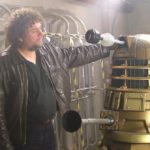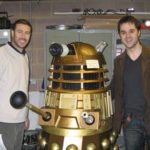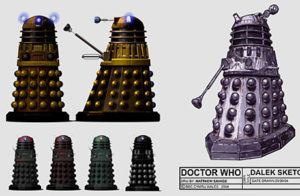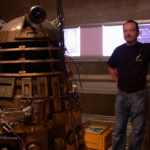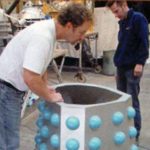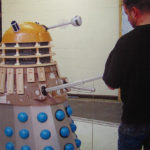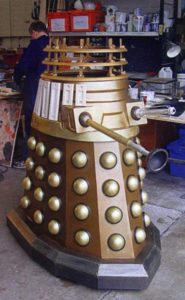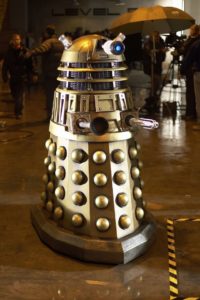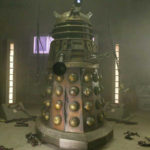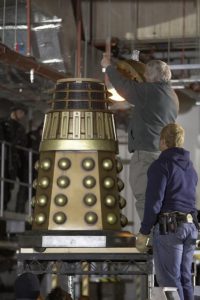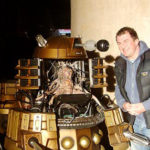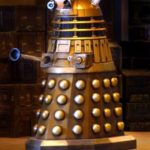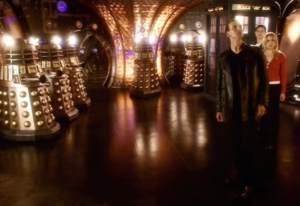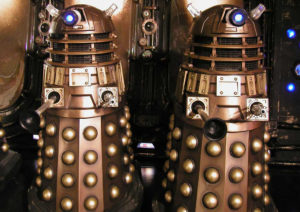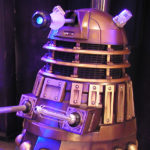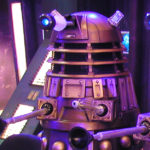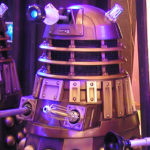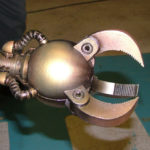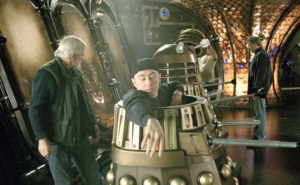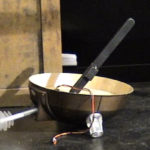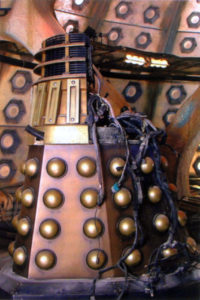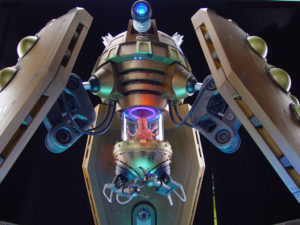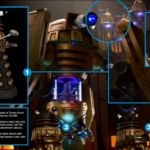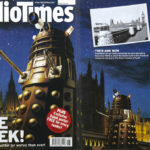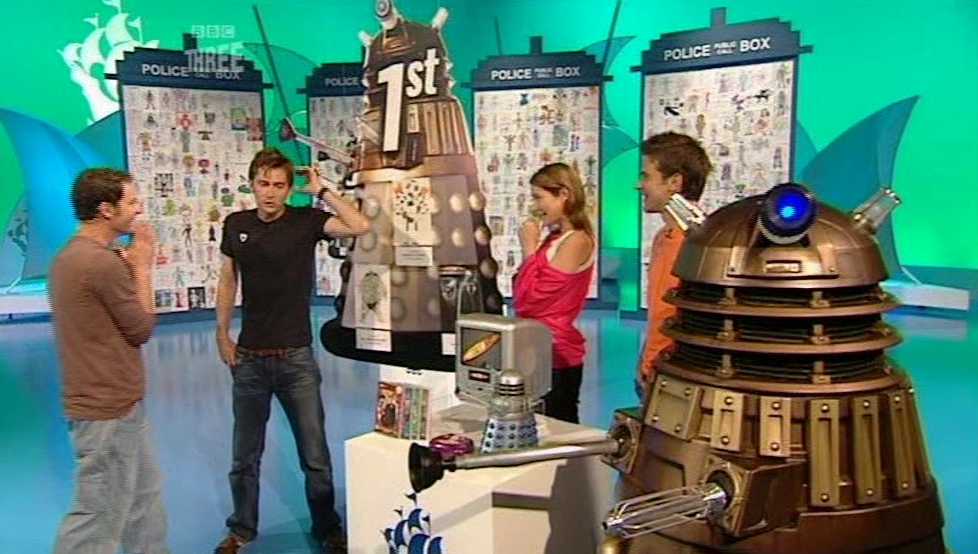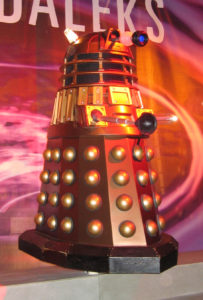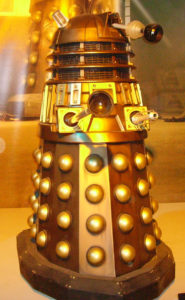The Rebirth of the Dalek
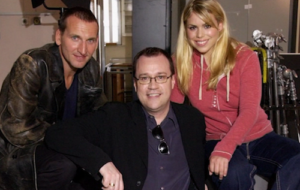
Russell T Davies (centre) with Christopher Eccleston and Billie Piper
After the original TV series ended in 1989, the Daleks disappeared from our screens for a long time. Aside from an occasional cameo, their only other notable appearance was in the 1999 Comic Relief special. Although it did feature an original TV Dalek prop, and it was entertaining, it was hardly the triumphant return that all the fans craved. But, despite all the odds, Doctor Who really did manage a triumphant return, just a few years later.
Russell T Davies had been pitching Doctor Who to the BBC on a casual but persistent basis for a long time. It was during the autumn of 2003 that his final attempt was made, and one storyline idea drew heavily on an acclaimed ‘Big Finish’ audio drama by Rob Shearman called Jubilee. With production of the TV series confirmed, the Doctor’s oldest foes were very much at the centre of their plans, and Return of the Daleks soon became Creature of Lies as Rob Shearman developed his script. Davies was encouraged to bring in the Daleks right at the start but he insisted they be held back to give a mid-season re-launch.
Just as had happened during the planning of Remembrance of the Daleks, the estate of Terry Nation played hardball over the rights. In July 2004 negotiations were said to have broken down as complaints were made once again that the Daleks were no longer true to their original concept. Unsurprisingly, at the last minute, a deal was struck with Nation’s agent, Tim Hancock on 4th August – and the Daleks were secured.
Keeping in Shape
During September 2004, Edward Thomas and the Art Department were given the task of coming up with a new Dalek design for the series. The overriding feeling of those involved was that the design was a classic and the basic silhouette of the Dalek should not be changed. However, it was conceded that it still needed updating to a more modern look. The moulded design of the Remembrance of the Daleks Imperial props had gone some way to achieving this in the latter years of the original run but Thomas felt that even more could be done to “Mini Cooper” the Dalek. In the same way the famous 1960s small car had been ‘bulked up’ in the modern designs of the Noughties, the Dalek could also be brought up to date without losing the original appeal.
On 18th September, concept artist Matt Savage submitted the design which would become the template for the new series. Russell T Davies had insisted that the props be gold and bronze and that was his mantra throughout the design process. For the sake of due diligence, a set of other possible colour schemes were drawn up, but the show-runner’s preference was kept. Over the following couple of weeks, the details of the props were refined and by the end of September Matt Savage had submitted his detailed studies for other components including the head, to illustrate for the prop-makers how the cowl and head-grooves should look.
One feature of the original design was that the cowl was completely enclosed on the top surface but this would need to be addressed in the construction stage if the Dalek had any hope of pointing its eye more than a few degrees above the horizontal.
It was the shoulder section that was given the largest overhaul. Just as the Imperial Daleks had done away with the mesh, the new look would also follow a similar approach. The slats were given some depth with an added recess as detail and were bolted to the shoulders. Further details were added to the gun and arm boxes. The gun was improved although retained the familiar style and, perhaps surprisingly, the plunger was retained and even given its own extra detailing.
An element that had been lost from the eye, over the years from the Daleks of the 1960s, was the ability of the pupil to light up. This was the perfect chance to for that element to return and as such the eye was given a blue light and extra detailing. As Russell T Davies preferred the larger lights of the AARU Movie Daleks, a more modern larger set of lights was added to the dome.
The skirt section remained relatively unchanged with the exception of some rings added around the hemispheres and was sat on a larger fender akin to the AARU Movie Daleks.
Building Bronze
The task of constructing the Dalek fell to Mike Tucker of the BBC Post Production Model Unit (the final incarnation of the BBC in-house VFX department, and the forerunner of Tucker’s external outfit, The Model Unit). Tucker had worked on the final few seasons of the original Doctor Who run and was already commissioned to make a number of models for the new series.
The late decision of the inclusion of the Daleks meant the team had just three and a half weeks to complete the prop. Without the time to build a complete prop from scratch, they turned to fan Andrew Beech whom had in his possession a number of Daleks made by Steve Allen, Alistair Lock and Dave Brian. Beech was well known to Tucker having supplied parts of his collection to the Dimensions in Time Children in Need charity special in 1993. Tucker took two Daleks that were essentially based on the 1960s versions from The Chase through to Evil of the Daleks.
Also available was a Dalek that had been made from the ‘Necros’ moulds first used in 1984. The Necros moulds produced a Dalek with a slightly more ‘upright’ skirt section. More about the Necros Daleks can be read on our Revelation of the Daleks page.
The team decided that the original classic Dalek was the best look and proceeded with the required modifications.
The upper halves of the two Daleks were dispensed with and work began on the skirts. One skirt was required to be distressed for use in the initial scenes the Dalek would appear in and so holes and cracks were put various places and a panel was adjusted to make it look as if it had been peeled back. There was a small error in the construction of the skirts by Allen, Lock and Brian whereby the angle where panels L1 and L2 meet is too shallow, resulting in an asymmetrical front.
Nick Kool created the new shoulder section. The new look section included a deep recess that ran around the circumference into which the new shaped moulded slats would be bolted. A dome was pulled from a cast of an Imperial Dalek dome and Scott Weyland created the new cowl and neck to finish the work.
In an effort to make it easier for the operator, the dome section was to be controlled by remote. Melvyn Friend fitted a series of motors into dome to allow this. However, a standard ‘manual’ controlled dome was also supplied in case of issues.
The Dalek was beautifully finished in several shades of bronze and gold and sent to Cardiff. We refer to this Dalek as ‘Mike Tucker-1’ or MT1.
Van Statten’s Base
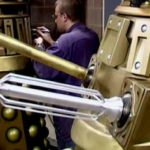
Final weathering taking place. The bronze arm stage was changed to silver for taping. Click for a larger view.
Once completed and tested, the new Dalek was prepared for its first recording work with Barnaby Edwards the first of the new operators. Location filming began on 25th October and moved to the Millennium Stadium in Cardiff on 26th October. The bare, industrial corridors underneath the complex featured extensively as the base of Henry Van Statten and the location work continued for several days. The Dalek was delivered to the stadium on the 25th where setting up of the various set elements was being carried out. Final weathering of the prop and painting of the ID badge on the dome took place in the afternoon.
The corridors of stadium were also a perfect backdrop for publicity photos to be taken. A number were taken from various positions but one in particular would go on to be used regularly for merchandising for years to come. The pictures reveal that the outer arm stage of the Dalek was initially painted in gold, however by the time shooting began this had been changed to silver. Another change was also made to the dome movement mechanism. Operator Colin Newman had rebuilt Mervyn Friend’s original design to better suit his method of working.
Shooting commenced on the scenes with the Dalek in its damaged state in the cell. The top section was dirtied-down and placed on the distressed version of the skirt to complete the effect. The scenes filmed included the Doctor’s first meeting with the Dalek and Rose empowering it when she places her hand on it.
The new detailed plunger got its first close ups during these scenes when a much derided element of the original Dalek design was laid to rest, explaining its retention in the design stage. Although finally achieved with CGI, it was revealed that the sucker could, in fact, literally suck the life from an enemy when it grasps its face. It was also able to manipulate controls in a manner never seen before onscreen.
Once these scenes were complete the top section of the Dalek was cleaned overnight and returned to the standard skirt section. Filming recommenced the next day. Shooting included the scene of the ‘restored’ Dalek reaching the bottom of a set of stairs ready to elevate – an effect which was also ultimately achieved with CGI.
Daleks had been seen to ascend stairs in the classic series but not until their final story. Keen to dispel any derision from a new audience, this scene was inserted early on in the story. Another effect also completed by CGI was another new addition to the Daleks’ arsenal of terror – the ability to rotate its mid-section and therefore destroy targets all around.
On 1st November, scenes were shot in which the Dalek faced Van Statten’s troops in battle.
At one stage, the Dalek was lifted on a platform during the battle. The platform was painted out during post production and this time the actual Dalek prop was seen to be floating.
A special ‘opened’ top section was also created by Tucker and his team for the final scenes of the story. This was placed on the skirt of the MT1 and at the climax of the story CGI was used to ‘open’ the Dalek before changing to the practical prop revealing the Dalek mutant inside which had been created by Neill Gorton at Millennium FX.
Unfortunately, all plans to keep the new look Daleks secret were ruined at the start of November when a photo of the Dalek on location was leaked and spread like wildfire across the internet and tabloid newspapers. In Newport, studio work on the episode continued throughout November and the final work was completed on the 26th.
Bad Wolf
As the series progressed and production reached towards a conclusion, one phrase had transcended its original status of a joke had turned into the arc story of the season: “Bad Wolf”. Although not directly related to the reveal, the resolution to the threat would involve the Daleks as Russell T Davies decided that they would make their multitudinous return at the end of the season.
Their inclusion was woven, rather surreally, into a story about reality television as the Daleks decided the best way to subjugate mankind was through their television sets – and the unlucky losers of the games would become fodder for conversions into Daleks.
Conscious of the old problems of having Daleks attempting long conversation with the Doctor, Davies originally had the Controller of the Gamestation as the main mouthpiece in the second episode but soon decided upon a better idea. To inject greater visual spectacle and enhance the Daleks’ presence, he decided to resurrect the idea of the Dalek Emperor, and relate him back to the unseen Time War.
The end of the first episode would reveal the Daleks, and then the second episode would feature a pitched battle with them. It had originally been intended that another new design of Dalek would feature in the episodes. These would have been created in CGI by The Mill. However, this had proved too costly to achieve and so to help with the budget, Davies’ script indicated that shots of multiple Daleks could be achieved with a simple “split screen” effect with several Dalek props. However, to create even this straight forward effect, there would need to be more than the one Dalek which had so far been built.
The Parting of the Props People
At the end of 2004, Mike Tucker, who had originally been lined up to supply the entire batch of props for series one, saw his involvement in the show ended prematurely, and the task of creating a new set of Daleks was given over to another company.
Specialist Models were contracted to build two new props but without the moulds which had created the original MT1, they would have to copy the finished prop instead. In order to save time, Specialist created a mould of the entire body of the Dalek – Fender, skirt and shoulders all in one piece. It meant that each new prop made by Specialist would be distinctively cast in one complete unit.
Mike Tucker’s expertise was still called upon so that the correct parts could be sourced to complete the new props. One of the Daleks would be fitted with a remote controlled dome whilst the other utilised the ‘classic’ method of a handle running from the back of the eyepiece down through the neck for the operator to control.
The two new Specialist props were painted to resemble the MT1 although a more basic approach was taken with fewer shades used. As the MT1 now stood out from the new props it was also given the new basic finish. All three Daleks were weathered in a similar fashion to MT1‘s original appearance.
The three new props each have their own distinguishing features and the weathering proves to be the easiest means to tell the three props apart:
MT1 can now be recognised by a vertical oil streak running down the centre of the slat over the front of the gunbox. Beneath the top hemispheres at the front of the skirt, two streaks run down, with both pairs off centre. The Dalek’s name features two large squares on the left. The neck section has a continuous oil run down the rings, just on the right-hand edge of the cowl.
New Series Dalek 2 (or NSD2) has prominent double oil-streaks at the rear of both gunboxes. Its name features a small white square at either end of the design. It has some light streaks in the centre of the middle slat and two larger streaks close to the inside edge of the armbox under the centre slat. This Dalek had the second remote controlled dome.
New Series Dalek 3 (or NSD3) has an oil streaks on the collar at the front and rear of the armbox. Its neck features a double-streak on the top two rings beneath the right-hand edge of the cowl. Its name has very little detailing towards the left side.
The Dalek operators were given the luxury of rehearsal time with the new props as finishing touches were still being made. The final day of preparations for filming was 22nd February 2005 and by lunchtime new suckers were primed and sprayed, and the new ‘claw’ fitting was tested. The fitting was needed for a scene of the Daleks attempting to break through a door by cutting through which was an idea that harked back to the very first Dalek story.
During the testing, an actual scene was being shot elsewhere in the building, as Christopher Eccleston performed repeated takes for the cliffhanger at the end of Bad Wolf. Due to the lack of sound-proofing at Q2 Studios, the Dalek rehearsals were constantly interrupted when the bell rang to denote shooting in progress. When the cameras weren’t rolling, work continued to iron out the technical issues and it became a long and frustrating day for due to malfunctions with one of the two remote-control domes and the system for controlling the flashing lights.
By 3pm, movement tests had been carried out on the TARDIS set and by around 4pm the operators were ready to perform a short scene for director Joe Ahearne with Nick Briggs on hand for the voices.
The following day was a day off before shooting with the Daleks began.
In Studio
On 24th February, the Daleks were ready to go before the cameras and several famous shots were taken that morning of the props at the controls of the Gamestation. Four operators were used over the course of the filming – Barnaby Edwards was joined by Nicholas Pegg, Dan Barratt and David Hankinson. Dan Barratt generally operated NSD3 with the manual dome movement system.
During the afternoon, the Doctor’s final confrontation with his old enemies was shot, along with Rose’s emergence from the TARDIS as “Bad Wolf”.
On 1st March the sequences were shot of the Daleks advancing on the barricade. Due to the standard of their construction and the drone-like nature of the new Daleks, the three Daleks are very difficult to distinguish from each other, but the use of split screen during this attack (in a far more sophisticated method than was employed in Remembrance of the Daleks) only confuses the matter further.
On 4th March, the one and only physical FX shot featuring a Dalek was completed whereby Captain Jack shoots and destroys a Dalek inside the Tardis. NSD3 was initially used for the appearance of the Dalek then Danny Hargreaves moved in to set up the SFX sequence.
The upper half of the prop which had opened up at the end of Dalek was reused now with various enhancements and augmentation. The lower half of the FX prop was, perhaps surprisingly given the value, the skirt of the MT1 rather than a lightweight substitute. Some residue of the effect covered areas of the panels and required cleaning off prior to the next section of filming.
Production then moved to Enfys Television Studios where the afternoon of 5th March saw the shooting inside the Dalek Saucer and the Doctor’s materialisation there. Finally the 7th March saw the first sequence shot last – whereby the Daleks are at the controls of their ship, and then confront Rose Tyler after her arrival. This was Christopher Eccleston’s last day on Doctor Who.
The final work completed with the Daleks was on 14th March. The full sized props were shot against a green screen in order for them to be composited into shots with a practical model. This would be their new leader…
Imperial Majesty
The other new addition to the Daleks’ mythos in this episode was the Emperor. An old idea from The Evil of the Daleks was reborn as a three-shielded collosus with giant robotic arms. It was designed by Matt Savage and Dan Walker.
Created by Mike Tucker’s visual effects team as a practical model, this impressive prop was planned and constructed during February and March, mainly made from wood with plastic detailing. The miniature featured a plastic tank with a tiny mutant but, for close-ups, the full-sized practical mutant was reused.
The shooting of the large tank was done first on 14th March 2005 while The Emperor model was shot at Kendal Avenue on 16mm film on the morning of 23rd March. The work in the tank effectively destroyed the animatronic mechanism of the mutant.
The CGI budget also allowed for four new variations of the new new style Dalek to be inserted into the Emperor model work to expand the numbers of Daleks. One version harked back to the ‘Throne room’ Daleks of Evil of the Daleks in that the dome was painted black. Two variations had back domes and skirts – one of them with a circular saw attachment. And a version with what appears to be an enlarged gun instead of the usual sucker arm.
Promotion and competitions
Dalek premièred on 30th April 2005 and, as the Daleks had always been a big draw, the Radio Times took the opportunity to give the ‘New Series’ a second cover just weeks after the series had received its first. The cover took the famous images of Daleks crossing Westminster Bridge in 1964s Dalek Invasion of Earth as its inspiration and neatly tied up with 2005 General Election which was to take place later that week.
The magazine employed photographer and digital artist Ian McKinnell with taking set-up shots of the bridge and Parliament. To keep the surprise of the new look Dalek a secret he used a fan built Dalek to compose the image and get the perspective for the later digital work. He then travelled to Cardiff to get shots of the Daleks to superimpose onto his pictures. Four Daleks appeared on the cover although in reality it was only one Dalek repeated – NSD2. This was because it was the only one of the trio that was available. He then had the tricky task of digitally manipulating the single Dalek to appear as if there were four. The first Dalek was largely untouched and even retained the ID tag it would be seen with later in the season. The second Dalek was actually a flipped image of NSD2 and heavily ‘photoshopped’ to reverse the gun and arm. The third and fourth images were the correct way around.
The final cover was emblazoned with “Vote Dalek!” in reference to the election and went on to be voted the Greatest British Cover of All Time in 2008 and also won the PPA award for Cover of the Century. With the slight variance of paint livery to that which appeared in Dalek and different ID tag, eagle eyed viewers and readers may have got an early indication that the Daleks were to return later that season.
Blue Peter had crossed paths with Doctor Who many times since 1963. The show had featured promotions and competitions regularly since 1963. With the New Series’ future secure, plans were made for children to get involved in the second season. In 1967, the young viewers of Blue Peter were able to enter a ‘design a monster’ competition. In that case, the winner appeared on the show with their realised design. The same competition was run again and this time the winning design would actually feature in Doctor Who. The competition was announced in July and closed in August. On 17th August, the winner was announced as William Grantham with his ‘Abzorbaloff’. David Tennant was in the Blue Peter studio to reveal the winning design and NSD3 (voiced by Nicholas Briggs) was also on hand to give some facts about the number of entries.
NSD2 began a long term connection with the ‘Here For You!’ initiative run by BBC Wales. The BBC set up a roadshow that would visit various areas as part of a bigger plan of events for that region. NSD2 joined one of the two TV TARDIS props for the tour and could be seen in Camarthen.
Bronze at the Seaside
Around the time The Parting of the Ways was being recorded, plans were under way to extend the reach of Doctor Who from the TV set and into the real world.
There had been a number of exhibitions before but the story of the modern Doctor Who exhibitions begins in Brighton at the start of 2005 when Head of Resort Anne Grainger looked to her team for new ventures to widen the pier’s scope. Being a fan of the show, Jason Mannix from their Marketing and PR department suggested Doctor Who and knew the programme was coming back. After contacting the BBC, brand manager Ian Grutchfield put Brighton Pier in touch with Martin Wilkie, son of Bernard Wilkie whose involvement in Doctor Who and the Daleks is documented elsewhere on the site.
Martin Wilkie was the Design Director of Experience Design, a company which specialises in visual and animated displays. His previous work on the Longleat Exhibition, Llangollen (until 2003) and then the second Blackpool exhibition put him in a prime position to take on the job at Brighton. Russell T Davies became enthusiastically involved at the end of February and Experience Design were given the first six scripts to read in order to plan the exhibition.
Stuart Wescombe co-designed the project, working with the help of Ed Thomas in Cardiff, in order to bring as many original props to the exhibition as possible. One thing they couldn’t do, however, was use one of the three Dalek props that had been built for television and so Experience Design invested in a brand new, authentic prop from the same source. Coming only a few months after they had supplied the TV props, Specialist Models were commissioned to create another Dalek as per the two they made for television.
This prop – ‘New Series Dalek Brighton’ or Dalek NSDB was faithfully built using the same methods as the TV Daleks. The only difference was that the prop was not weathered so the skirt and shoulders remained in a more pristine gold. The Dalek was installed on a raised platform giving the illusion it was hovering, and a button was created which said “Do not press!” The predictably-disobedient young visitors would then be startled by the Dalek coming to life, thanks to an animatronics movement fitted by Jeremy King.
The doors of the Brighton pier exhibition opened in on 14th May 2005 and nearly 40,000 people visited in the first two months alone. Also at the exhibition were the NSD ‘Opening Dalek’, now fitted to the distressed skirt from Dalek, The Emperor model and ‘The Wilkie Dalek’ (Dalek Two-8). The exhibition finished in November 2005 and the installation, along with the Dalek, was then shipped to the National Space Centre, Leicester, where it stayed until January 2006. Dalek Two-8 was sent to Cardiff for a new, permanent exhibition…
Exhibition Daleks Invade Cardiff
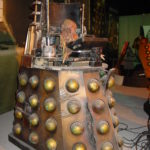
The ‘Opening/Distressed’ Dalek on display at Cardiff in 2006. Picture – Jon Green. Click for a larger view.
A ‘permanent’ Doctor Who Exhibition at Cardiff (Doctor Who Up Close) opened in late 2005 at the Red Dragon Centre. As with the Brighton display, the exhibition featured mainly exhibits from the ‘New Series’. Specialist were asked to provide a second exhibition prop for the display – ‘New Series Dalek Weathered’ or Dalek NSDW. This Dalek was weathered in the style of the TV Daleks unlike the Brighton prop. It did, however, feature similar animatronics. Before joining the exhibition, Dalek NSDW had a day out at the Cardiff Waterstone’s store in November.
Also on display were the ‘Opening/Distressed’ Dalek and Dalek Two-8 (The Wilkie) that had moved from Brighton.
This Planet Earth
During the late spring of 2005, when the country was feeling feverish about Daleks once again, a company called This Planet Earth began negotiating with the BBC for a license to make replicas of the new Bronze Daleks.
TPE had been making replica props since 1996 and their range already included a number of variants from the classic series. Following TPE’s acquisition of the license, Martin Wilkie at Experience Design and BBC Worldwide collaborated with them to supply a Dalek from which they could take moulds and measurements. The ‘Opening’ Dalek from the Brighton Exhibition was borrowed and taken to their workshops, allowing them to measure the cut-away neck in cross-section. A full size prop was also borrowed, from which they removed all slats and moulded the shoulder section.
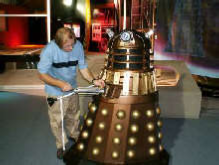
Toby Chamberlain of ‘This Planet Earth’ measures up the Brighton Dalek
TPE staff also visited the Doctor Who Exhibition at Brighton pier where they took measurements. The company made note of the slight variations between the original MT1 Dalek and those created afterwards. By the end of the year, work was underway in creating their new replicas.
The return of Doctor Who had been a triumphant hit and the Daleks had proved themselves as popular as ever to a new young audience. Despite losing the main star after just one season, the second season had been secured and the Dalek props would be wheeled out for use again in just a few months time…
